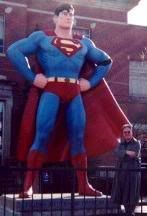| Pop Culture Gadabout | ||
|
Sunday, October 12, 2008 ( 10/12/2008 04:37:00 PM ) Bill S.  "NO BASEBALL LIFER LIKES TO SEE A FAN LEAVE UNHAPPY." There's a neat little pun in the title of Adam Beechen & Manny Bello's new black-and-white graphic novel, Dugout (AiT/Planet Lar). Look at the cover, with hero baseball manager Cookie Palisetti in his uniform, holding onto a bag of bats, ball and what you first don't notice as pickaxes - and you can see the joke. Dugout is both a baseball and a prison break story with the in-hock Cookie digging himself out of his multiple personal dilemmas by arranging the escape of a promising young pitcher who's been jailed for killing his abusive parents. "NO BASEBALL LIFER LIKES TO SEE A FAN LEAVE UNHAPPY." There's a neat little pun in the title of Adam Beechen & Manny Bello's new black-and-white graphic novel, Dugout (AiT/Planet Lar). Look at the cover, with hero baseball manager Cookie Palisetti in his uniform, holding onto a bag of bats, ball and what you first don't notice as pickaxes - and you can see the joke. Dugout is both a baseball and a prison break story with the in-hock Cookie digging himself out of his multiple personal dilemmas by arranging the escape of a promising young pitcher who's been jailed for killing his abusive parents.Like most caper stories, Dugout is 80% build-up and 20% bang. So writer Beechen opens with the plight of 1959 L.A. Pioneers manager Palisetti and his failing team. In major debt to a bookie, facing a disgruntled owner on the verge of dumping the team, Cookie arranges an exhibition game at Los Diablos State Correctional Facility, where the would-be pitching star, Billy Luther, is incarcerated. Thankfully for Cookie, the prison's warden proves to be the kind of sports-addled official we're accustomed to from flicks like The Longest Yard, so our hero isn't watched too closely. As a manager, we're told, Palisetti is an improvisational kind of guy ("There's a glorious desperation to everything you do," Warden Charles notes at one point), and his jailbreak proves to be just as half-planned. Enlisting the aid of a former inmate currently pitching for the Pioneers, Wilbur "The Rev" Niles, and a geezerly con who's been digging a tunnel out of the prison for years, the team manager puts his half-plan in play. In so doing, he hopes to save his team and impress a girl, Billy's shapely full-lipped sister Irene. As a jailbreak yarn, Dugout doesn't throw a lot of curve balls. It follows its hero through set-up and execution without much in the way of plot complications. The story's primary pleasures rest in watching its marginal characters go about their business: hapless Cookie as he ineffectually attempts to talk a thug out of breaking his fingers, ersatz born-again "Rev" Niles as he proffers fabricated scripture, horny jailbird Stevens as he digs his hole on the promise of a hooker with "jugs as big as my head." Artist Manny Bello (who first teamed up with Beechen four years ago in Hench) gives this lot a suitably lived-in appearance: even his Irene isn't too much of a looker. Back when I first read Hench, I took issue with some of Bellow's unconvincing figures, but it's less of an issue in Dugout. If, at times, Beechen's chatty set-up overpowers the artist's visuals (there are a few too many talky headshots), the artist's rumpled, dust-flecked style is definitely suited to the story's period milieu. These mugs live in a leather-stitched world, and they wouldn't have it any other way. Neither, for that matter, would we . . . Labels: modern comics # | |
|
|

